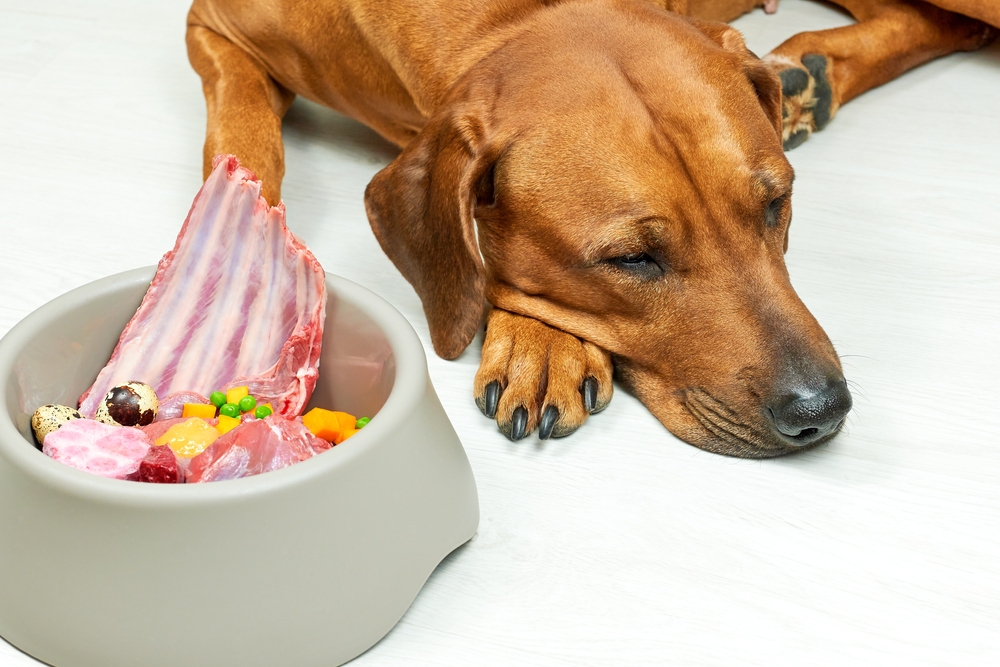If your dog is suddenly turning up their snout at the dog bowl, your first question will understandably be, “Why has my dog stopped eating?” Are they unhappy with the food? Are they upset about something else? Could this be a medical emergency? Also, how long can a dog go without eating while you figure out what the real problem is here?
To be sure, dealing with a dog who won’t eat is stressful for a doting Dog Owner. But, while you certainly will want to check in with your vet, there’s no need to jump to scary conclusions. As we’ll cover in this article, there are many reasons why a dog might stop eating. We’ve also got some steps that you can take to keep your pup well-fed and healthy.
Why has my dog stopped eating?
Unfortunately, our doggos can’t tell us why they’ve decided to skip a meal or two. Most commonly, a loss of appetite is due to one of the following:
- Stress, big and small. Whether it’s a big house move, their beloved Owner going on holiday, or simply a schedule change, dogs often experience a loss of appetite under stress. It’s quite common, for instance, for a pup to skip their first meal while at their caring Pet Sitter’s house, no matter how many times they’ve visited in the past! Consider whether any recent changes in their life might have prompted them to stop eating
- There is a problem with the food. Foods that have expired or gone stale will often trigger a dog’s internal warning system. This can also happen if you’ve recently switched your dog’s food without giving them a proper transition period or they are not happy with the new food
- There is a problem with the environment. Just like us, our dogs sometimes need the right ambiance to enjoy a meal. If their food bowl has been moved to a high traffic part of the house or they’re being asked to eat around another pet who intimidates them, they may refuse the meal altogether
- They’re suffering from a toothache. Tooth sensitivity could be the reason why your pup is hesitant to eat their normal food and is often coupled with other symptoms like bad breath, drooling and dropping food while eating. Until you can get them in to see the vet, you might try softening your dog’s kibble with warm water
- Their medication or a recent vaccination is affecting their appetite. If you recently changed your dog’s medication or took them in for a vaccine booster, they may experience a temporary loss in appetite
- They are entering old age. Senior dogs naturally slow down and may become less food motivated
- There is an underlying health issue. Even if you think that your dog has stopped eating for any of the previous reasons, it’s still very important to have your vet rule out an underlying health condition. This is recommended for any changes in eating habits, and especially true if your dog has not eaten a meal in 48 hours. If you’re also asking yourself, “How long can a dog go without water?” that’s even more reason to get your dog to the vet. While dogs can be okay after three or four days without food, the same is not true for water and is considered a medical emergency
If you’ve ruled out a medical issue, how can you get your dog to start eating again?
After your vet has cleared your dog of any medical-related loss of appetite, you might feel unsure of how to proceed. Here are a few ideas on how to get your dog to revisit their food bowl with gusto:
- Transition them onto a more interesting diet. If you have a picky eater on your hands, swapping out their dry food for something fresh and flavourful might be just the thing to get them drooling. Consider transitioning them onto an all-natural raw diet or mixing some healthy treats like boiled chicken or carrots into their regular meals
- Swap out your training treats with other kinds of rewards. If you’re familiar with our blog, you know that we’re big fans of positive reinforcement training! After all, treat-based training is one of the fastest and most effective ways to train a dog. But, if your dog seems to be losing interest in their regular meals, consider going easier on the treats during your training sessions. You might do this by cutting your training treats into smaller pieces or incorporating their favourite toys as rewards to balance out the treats.
- Set up their eating area for success. Make sure your dog has the chance to eat in a quiet, peaceful part of the house. And, if your dog struggles with resource guarding, make sure to work specifically on that behaviour so that mealtimes are never stressful
- Make meals interesting with toys and games. Snuffle mats, kibble dispensing toys, and even fun scavenger hunts can be used to light your dog’s culinary spark! Try out a few different methods to find one that makes your dog look forward to their meals
- Schedule in some added exercise. As opportunistic eaters, dogs will typically eat regardless of whether they’ve had their daily exercise. But, by incorporating more play, walkies with their favourite Dog Walker, and organised exercise activities, you might be able to jumpstart their metabolism and enthusiasm about dinner
There’s no easy answer to the question, “why has my dog stopped eating?”
Searching for the reason why your dog has stopped eating can be an overwhelming process. And it can take some time to figure out whether the problem is behavioural, environmental, or medical. By far, your best resource is your dog’s vet, so don’t hesitate to reach out for your pup’s wellness and safety.

